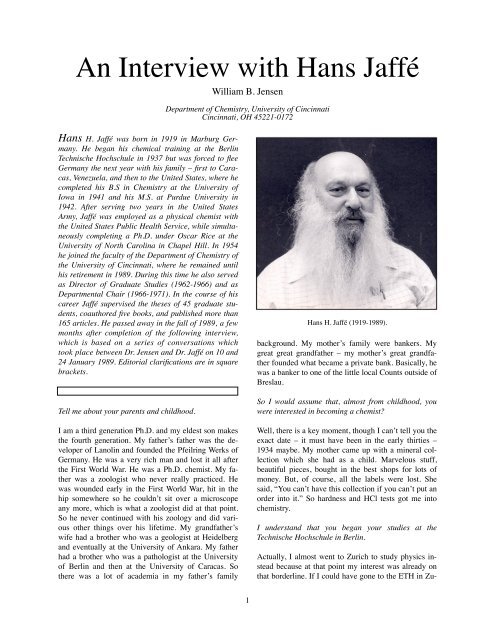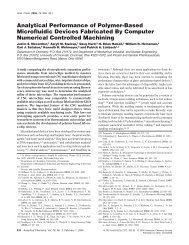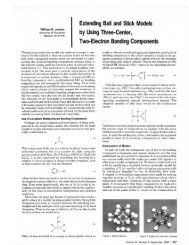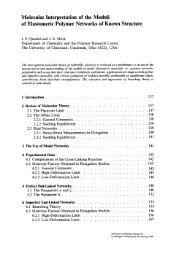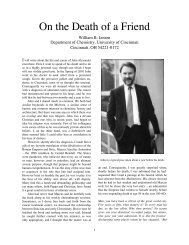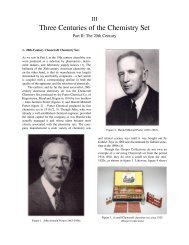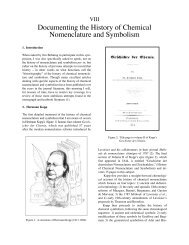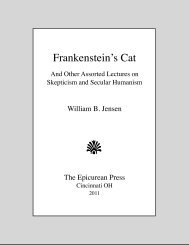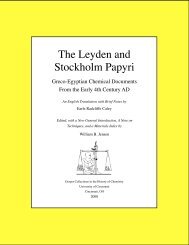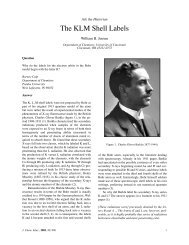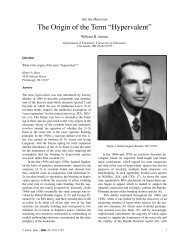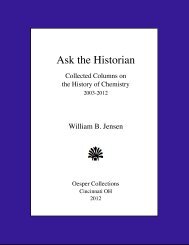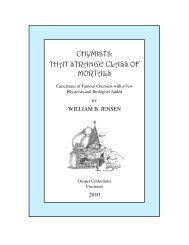043. Hans Jaffe.pdf - University of Cincinnati
043. Hans Jaffe.pdf - University of Cincinnati
043. Hans Jaffe.pdf - University of Cincinnati
Create successful ePaper yourself
Turn your PDF publications into a flip-book with our unique Google optimized e-Paper software.
An Interview with <strong>Hans</strong> Jaffé<br />
<strong>Hans</strong> H. Jaffé was born in 1919 in Marburg Germany.<br />
He began his chemical training at the Berlin<br />
Technische Hochschule in 1937 but was forced to flee<br />
Germany the next year with his family – first to Caracas,<br />
Venezuela, and then to the United States, where he<br />
completed his B.S in Chemistry at the <strong>University</strong> <strong>of</strong><br />
Iowa in 1941 and his M.S. at Purdue <strong>University</strong> in<br />
1942. After serving two years in the United States<br />
Army, Jaffé was employed as a physical chemist with<br />
the United States Public Health Service, while simultaneously<br />
completing a Ph.D. under Oscar Rice at the<br />
<strong>University</strong> <strong>of</strong> North Carolina in Chapel Hill. In 1954<br />
he joined the faculty <strong>of</strong> the Department <strong>of</strong> Chemistry <strong>of</strong><br />
the <strong>University</strong> <strong>of</strong> <strong>Cincinnati</strong>, where he remained until<br />
his retirement in 1989. During this time he also served<br />
as Director <strong>of</strong> Graduate Studies (1962-1966) and as<br />
Departmental Chair (1966-1971). In the course <strong>of</strong> his<br />
career Jaffé supervised the theses <strong>of</strong> 45 graduate students,<br />
coauthored five books, and published more than<br />
165 articles. He passed away in the fall <strong>of</strong> 1989, a few<br />
months after completion <strong>of</strong> the following interview,<br />
which is based on a series <strong>of</strong> conversations which<br />
took place between Dr. Jensen and Dr. Jaffé on 10 and<br />
24 January 1989. Editorial clarifications are in square<br />
brackets.<br />
Tell me about your parents and childhood.<br />
I am a third generation Ph.D. and my eldest son makes<br />
the fourth generation. My father’s father was the developer<br />
<strong>of</strong> Lanolin and founded the Pfeilring Werks <strong>of</strong><br />
Germany. He was a very rich man and lost it all after<br />
the First World War. He was a Ph.D. chemist. My father<br />
was a zoologist who never really practiced. He<br />
was wounded early in the First World War, hit in the<br />
hip somewhere so he couldn’t sit over a microscope<br />
any more, which is what a zoologist did at that point.<br />
So he never continued with his zoology and did various<br />
other things over his lifetime. My grandfather’s<br />
wife had a brother who was a geologist at Heidelberg<br />
and eventually at the <strong>University</strong> <strong>of</strong> Ankara. My father<br />
had a brother who was a pathologist at the <strong>University</strong><br />
<strong>of</strong> Berlin and then at the <strong>University</strong> <strong>of</strong> Caracas. So<br />
there was a lot <strong>of</strong> academia in my father’s family<br />
William B. Jensen<br />
Department <strong>of</strong> Chemistry, <strong>University</strong> <strong>of</strong> <strong>Cincinnati</strong><br />
<strong>Cincinnati</strong>, OH 45221-0172<br />
1<br />
<strong>Hans</strong> H. Jaffé (1919-1989).<br />
background. My mother’s family were bankers. My<br />
great great grandfather – my mother’s great grandfather<br />
founded what became a private bank. Basically, he<br />
was a banker to one <strong>of</strong> the little local Counts outside <strong>of</strong><br />
Breslau.<br />
So I would assume that, almost from childhood, you<br />
were interested in becoming a chemist?<br />
Well, there is a key moment, though I can’t tell you the<br />
exact date – it must have been in the early thirties –<br />
1934 maybe. My mother came up with a mineral collection<br />
which she had as a child. Marvelous stuff,<br />
beautiful pieces, bought in the best shops for lots <strong>of</strong><br />
money. But, <strong>of</strong> course, all the labels were lost. She<br />
said, “You can’t have this collection if you can’t put an<br />
order into it.” So hardness and HCl tests got me into<br />
chemistry.<br />
I understand that you began your studies at the<br />
Technische Hochschule in Berlin.<br />
Actually, I almost went to Zurich to study physics instead<br />
because at that point my interest was already on<br />
that borderline. If I could have gone to the ETH in Zu-
ich, I would have been a physicist. The only reason I<br />
am a chemist today is when I came to this country and<br />
the Registrar at the <strong>University</strong> <strong>of</strong> Iowa evaluated me,<br />
he found that within a year’s work I could easily get a<br />
B.S. in chemistry, but it would take two years for a<br />
B.S. in physics. That’s what made the decision.<br />
During your brief stay at the Technische Hochschule,<br />
did you have contact with any famous chemists or<br />
physicists?<br />
Well, <strong>Hans</strong> Geiger gave the big physics lecture and<br />
Westphal <strong>of</strong> the Westphal balance gave the physics lab.<br />
I don’t know that the chemists were particularly well<br />
known people. [This is the wrong Westphal. The balance<br />
actually dates from the first half <strong>of</strong> the the 19th<br />
century].<br />
What were your courses like?<br />
It was very interesting, all kinds <strong>of</strong> qualitative analysis<br />
– real systematic goods – plus, I don’t remember how<br />
many preps were required. The preps I was assigned<br />
were not particularly easy ones for a beginner: aluminum<br />
chloride and titanium trichloride. The laboratory<br />
was open from 8:00 am to 6:00 pm Monday through<br />
Friday. I’m not sure whether Saturday was also a full<br />
day or a half day. You went in and did what you wanted. You were supposed to take this book and do all<br />
<strong>of</strong> the preliminary experiments and then demonstrate to<br />
the Assistant that you understood them. Then you were<br />
given your unknowns and you worked on them. During<br />
my year there, I got my qual done but I didn’t get most<br />
<strong>of</strong> the quant or the preps done. I still think qualitative<br />
analysis is the most fun and that it teaches you the<br />
most about chemistry. If I were to teach Freshman lab<br />
today, there would be at least one full quarter <strong>of</strong> qualitative<br />
analysis.<br />
A slightly out <strong>of</strong> focus <strong>Hans</strong> at age five. Xmas 1924.<br />
WILLIAM B. JENSEN<br />
2<br />
Rabbit hunting as a child in Germany. <strong>Hans</strong> wrote on the<br />
back <strong>of</strong> this photo, “Mein erstes Kaninchen,” which may<br />
mean, “My first reviewer.”<br />
Given your developing interest in theory, did you have<br />
a preference for the theoretical physics courses versus<br />
the laboratory chemistry courses?<br />
No, I wouldn’t say that. Where my physics interest<br />
came was from reading on radioactivity. It wasn’t<br />
really theoretical physics; it was atomic structure versus<br />
chemistry.<br />
Was there much atomic structure integrated into the<br />
chemistry courses or were they largely descriptive?<br />
No. It was outside reading mostly.<br />
Tell me about leaving Germany. I understand that you<br />
and your parents originally went to South America.
<strong>Hans</strong> as a teenager with his “Motorrad.”<br />
My uncle, who had been a pathologist at the <strong>University</strong><br />
<strong>of</strong> Berlin, got fired in 1936 and got a “Ruf”' from the<br />
<strong>University</strong> <strong>of</strong> Caracas in Venezuela. He became well<br />
established in Caracas as the first and only pathologist<br />
at the university and got the rest <strong>of</strong> his family in there<br />
at a time when it was virtually impossible to get anywhere.<br />
I remember the day that we had somehow managed<br />
to get an appointment at the U.S. Embassy in<br />
Berlin. When we arrived, there were lines around the<br />
block. I remember one guy pushing through the lines<br />
waving his American passport above him. And, <strong>of</strong><br />
course, I got pulled in. But I mean, there were millions<br />
<strong>of</strong> people wanting to leave Germany and they couldn’t<br />
have cared less where they went. I don't care what embassy<br />
it was, you would find lines like that – American<br />
worse than others. My cousin, who at that time was a<br />
Ph.D. candidate in Zurich, managed to buy (I don’t<br />
know what he had to pay for it) a visa to Paraguay with<br />
a transit visa through Uruguay. On that visa you were<br />
supposed to be able to get into Switzerland. Everyone<br />
was using these fake visas. Unfortunately, they caught<br />
on to that before I left. That was in late 1938. How<br />
could you get out? You could only take with you ten<br />
marks or $7.50 – at that point probably worth $2.50.<br />
AN INTERVIEW WITH HANS JAFFE<br />
3<br />
You stayed in Caracas a year and a half before coming<br />
to the United States. When you came here, had you already<br />
made arrangements to go to the <strong>University</strong> <strong>of</strong> Iowa?<br />
Yes, I came as a student. Somebody got me a scholarship<br />
and a place to stay rather cheaply at a co-op<br />
house. So that was my first year over here. Interestingly,<br />
the Registrar at Iowa said he would count my<br />
high school leaving exam as two years <strong>of</strong> college. He<br />
said, “Write down the number <strong>of</strong> hours that you spent<br />
in every course in those last two years in high school<br />
and your year in the TH and we will translate them into<br />
our credit equivalents.” When he finished, he said,<br />
“You are shy three credits <strong>of</strong> high school English, three<br />
semester hours <strong>of</strong> college English, six semester hours<br />
<strong>of</strong> college social science, and a certain amount <strong>of</strong><br />
chemistry.” So I went to the Head <strong>of</strong> the English Department,<br />
and he said, “You won’t need your German<br />
literature and your high school English can wait.” So<br />
that left me with a course in English – any course in<br />
English. I ended up taking English Drama from the<br />
beginning to 1642. Can you imagine me, with my English<br />
still being very, very shaky, competing against<br />
seniors and graduate students in English and Dramatic<br />
Arts in a course dealing with pre-Shakespearean English?<br />
We read one play a week. I got a C because the<br />
guy felt I got a raw deal. On the other hand, in the social<br />
sciences, I took a course in European culture from<br />
a South African – a Boer – who had been educated in<br />
Amsterdam, Berlin and London. A beautiful course. Of<br />
course, there I had more background than anybody<br />
else. It was nice, it was lovely. I enjoyed it. And then I<br />
took chemistry, lots <strong>of</strong> chemistry.<br />
Did anyone in chemistry at Iowa influence you or was<br />
there really no opportunity, given your brief stay?<br />
Influence, no. Nobody had much influence on me. I did<br />
my best to get through. The guy I remember best was<br />
my organic pr<strong>of</strong>essor. I went to a few <strong>of</strong> his lectures<br />
and I found that he just stood there and read the book<br />
to us and did some bad demonstrations, so I stopped<br />
going. So he called me in and he said, “If you don’t<br />
come to class, I'm going to have to do something.” And<br />
I said, “What’s my grade?” He said that it was a good<br />
B, so I told him, “That’s good enough for me, thank<br />
you.” And I never went to another class.<br />
Did he give you the B in the end anyway?<br />
Oh sure. What could he do?<br />
What determined your choice to go on to Purdue for<br />
the Masters?
I got a TA and then a fellowship.<br />
You applied to a number <strong>of</strong> schools?<br />
I applied to a whole bunch <strong>of</strong> schools and that was the<br />
only thing I could get – a half-time TA at $37.50 a<br />
month. By the time I got there, they didn’t want to put<br />
me in the lab. Antisemitism in this country was still<br />
pretty bad. So they gave me a fellowship for $60 a<br />
month. The Chair at Purdue, Henry Bohn Hass, was a<br />
SOB and lousy teacher.<br />
Whom did you work for at Purdue?<br />
The project was Henry Hass, but my direct supervisor<br />
was Tommy DeVries. Tommy DeVries was a nice guy.<br />
He may still be alive, I’m not sure. I saw him three or<br />
four years ago, an old man still sitting in an <strong>of</strong>fice doing<br />
something.<br />
Did you interact with any other faculty?<br />
M. G. Mellon and I had an interesting interaction. I<br />
took the chemical literature course with him. He assigned<br />
a bibliography. So I asked if I could I bring in<br />
my tray <strong>of</strong> cards. He agreed and I got an A. It was a<br />
tray <strong>of</strong> cards dealing with papers that interested me.<br />
So you had put it together for your own interest independently<br />
<strong>of</strong> the course?<br />
Sure.<br />
What was your Masters project on?<br />
Separation <strong>of</strong> enantiomorphs by some process <strong>of</strong><br />
chromatographic adsorption. It doesn’t work worth a<br />
damn. As a matter <strong>of</strong> fact, the best way to do it is to<br />
adsorb the pair <strong>of</strong> optical isomers directly onto an optically<br />
active absorbent. That’s the way it will work – it’s<br />
been made to work that way. We made it work too. But<br />
I have two left hands, I can’t do good lab work.<br />
I assume the reason that you didn’t go on directly to the<br />
PhD. was that both the army and marriage occurred at<br />
this juncture.<br />
As a matter <strong>of</strong> fact, Henry Hass had me drafted. Henry<br />
Hass and I didn’t get along very well, so he called the<br />
draft board and had me drafted. Haas was a dictator<br />
from the word go and his right hand man was E. T.<br />
McBee who, for 20 years after Haas left, continued<br />
that dictatorship.<br />
WILLIAM B. JENSEN<br />
4<br />
Tell me about your experiences with Uncle Sam.<br />
I shipped around the country for two years or so, and I<br />
got to Tulelake, California, right on the northern border,<br />
where they had one <strong>of</strong> the Japanese National internment<br />
camps. I was a so-called medic and was assigned<br />
to the infirmary. The Captain there was intelligent<br />
and he saw that he could use me. So he said, “Do<br />
you want to become a lab technician?” I said sure. I<br />
went down to San Francisco and bought myself a couple<br />
<strong>of</strong> books and for six months was his lab technician.<br />
This was followed by a lot <strong>of</strong> short-term assignments<br />
but, wherever I was, I managed to find myself<br />
something to do. In Medford, Oregon, I went to the<br />
infirmary thinking I would be a lab technician again<br />
and, indeed, they needed one. They were just setting up<br />
a mass screening and I was the lab technician replacement.<br />
Each patient would give me a urine sample and I<br />
had 13 minutes per patient to run the necessary tests. It<br />
wasn’t that difficult. I stayed there for three or four<br />
weeks and I set things up for them. It was trivial. They<br />
gave me Master Sergeants to work with. I was their<br />
boss, though just a buck ass Private.<br />
In Camp Ellis, Illinois, I couldn’t find a good job<br />
like that, so some <strong>of</strong> us went out nights and worked for<br />
Caterpillar Tractor. I don’t remember what they were<br />
making for the government, but they hired us and we<br />
laid around and did very little for eight hours each<br />
night and then went back to camp, stood for reveille<br />
and then found a quiet corner and went to sleep. Nothing<br />
to do all day. That's the way the army went.<br />
I finally got to Saipan. I found out later that I was<br />
shipped there as a replacement for a company clerk. I<br />
had somehow received a secondary specialty as a<br />
clerk. I guess they found out I could write. I didn’t<br />
know I was being sent there as a clerk, and the first<br />
night I got there I went to the lab and introduced myself<br />
to the Lieutenant Colonel in charge. He picked up<br />
the phone and I was a clerk no more. He needed me to<br />
replace one <strong>of</strong> his people in the lab. So I became the<br />
chemist in the lab. They made me a Private First Class<br />
as soon as they could, and then they made me a three<br />
striper. I was in for the fourth stripe by the time I left.<br />
So there I got treated properly.<br />
They had a Coleman Junior Spectrophotometer,<br />
but unfortunately without any directions or methods, so<br />
I put together a manual for us outlining the 20 or 30<br />
tests that we used. The most interesting part <strong>of</strong> it was<br />
when I found out about the blood sugar determinations<br />
that the army was doing. Blood sugar was done using<br />
the old Folin test and a Duboscq colorimeter, and you<br />
were told to use one <strong>of</strong> two reference solutions: a 100<br />
or a 200. So one day I made up a 150 and compared it.<br />
Reading it against the 100 reference, it read 180 and
eading it against 200 reference, it read 120. It didn’t<br />
follow the Beer-Lambert law. But nobody in the army<br />
had found out. I made a calibration curve so we could<br />
tell what we had. One day there came a Captain – a<br />
biochemist. I needed either a standard hemoglobin or a<br />
bilirubin solution, and asked him if he could make it<br />
for me. I needed it to calibrate something. So I had the<br />
Captain working, making my standards for me. It was<br />
fun.<br />
But God! – the day that the first hospital ship came<br />
over from Iwo Jima. We all knew they were coming so<br />
we had set up. We had a 2000 bed general hospital and<br />
we emptied the place out by that morning. That afternoon<br />
the ship came and unloaded 1000 casualties and<br />
they were in bad shape. We were doing blood tests on<br />
them all, the simplest blood test you can make in order<br />
to do them as fast as possible. You could assume, <strong>of</strong><br />
course, that these were reasonably normal bloods no<br />
microorganisms or anemias or anything like that. So all<br />
we had was this long series <strong>of</strong> copper sulfate bottles<br />
and you dropped the blood into the bottles and read the<br />
specific gravity. We did 1000 <strong>of</strong> those in two or three<br />
hours, and then I went out to collect blood from specific<br />
patients for specific tests. That is when I lost every<br />
bit <strong>of</strong> respect for nurses. The doctors, the <strong>of</strong>ficers, everybody<br />
was working on the patients. The nurses were<br />
sitting at the desk writing letters home and filing their<br />
fingernails. I haven’t been able to really talk to a nurse<br />
politely since. Here were these kids and they were in<br />
bad shape. The real decision for the Colonel and for the<br />
medical <strong>of</strong>ficers was, “Do we take the worst case first?<br />
He is going to die anyway? Should we save the third<br />
one and let the others go?” Those were the kind <strong>of</strong> decisions<br />
they were making. That is the kind <strong>of</strong> decision<br />
I’ve <strong>of</strong>ten talked about here. Why do we <strong>of</strong>fer a job to<br />
the best graduate student, who we know is going to go<br />
to Chicago or Harvard anyway, and in the process lose<br />
the second and the third? But it is very difficult to do –<br />
just as it was there.<br />
Well, anyway, I was in the army and in the army<br />
they give you those heavy boots. And, <strong>of</strong> course, they<br />
have no idea how to fit you for them, so for all three<br />
years in the army I had the wrong size shoes – 9EEE<br />
instead <strong>of</strong> 101/2D. I didn’t realize it either. I didn’t<br />
know my shoe size. You mustn’t forget that I was relatively<br />
recent in the country and American descriptions<br />
<strong>of</strong> sizes are different from European. Well, as a result, I<br />
had awfully sweaty feet and they were raw and hurt all<br />
the time. One day I decided I’d go to sick call and see<br />
whether they could find me some low cut shoes. That's<br />
all I was asking. The man looked at those feet and said,<br />
“Do you think you can get away from the lab for a day<br />
or two? I'm sending you to the ward.” That afternoon<br />
the ward <strong>of</strong>ficer came and said, “I don’t like that. I'm<br />
AN INTERVIEW WITH HANS JAFFE<br />
5<br />
sending you home.” For sweaty feet? You’ve got to be<br />
kidding! So three or four days before Christmas, 1945,<br />
I arrived in San Francisco on a hospital ship. You see, I<br />
was one <strong>of</strong> those poor patients and had to be evacuated!<br />
San Francisco harbor was full <strong>of</strong> troop ships<br />
which they didn’t have the shore facilities to unload.<br />
Douglas MacArthur had said he would get the troops<br />
home for Christmas, and he dumped them into San<br />
Francisco and San Francisco didn’t know what to do<br />
with them. As for us poor patients, we were immediately<br />
taken ashore to hospital, and the next morning we<br />
were put on planes and taken to the general hospital<br />
nearest our home. Well, at 11:00 on the 23rd <strong>of</strong> December,<br />
I checked into Cambridge General Hospital,<br />
Cambridge, Ohio. My home was listed as Indianapolis,<br />
Indiana. At 2:00 I said, “How about some shoes?”<br />
They sent me home on Christmas leave instead<br />
and by 2:30 I was on the road hitchhiking. But it was<br />
so cold and slick out that I turned around and hitchhiked<br />
back. When I got back to the base, I asked about<br />
the low cut shoes again. They said, “You won't be here<br />
long enough.” Three days later I was sent to Camp<br />
Atterbury, Indiana, for reassignment. I hitchhiked as<br />
usual and let them pay me three cents a mile.<br />
The army would reimburse for that?<br />
Oh yes – for travel by privately owned automobile.<br />
Anyway, by then I had enough points for discharge – in<br />
those days discharge was a matter <strong>of</strong> points. So I immediately<br />
got shipped from the reassignment to the<br />
discharge center, which was only across the street. I<br />
went through the entire discharge procedure but, a half<br />
hour before the final ceremony, comes a runner from<br />
headquarters saying, “You come with me. You can’t be<br />
discharged. Medical lab technicians are essential.” So I<br />
went back to the reassignment center, where they said,<br />
“Because you have been overseas for a year, you are<br />
entitled to 60 days <strong>of</strong> rest and recuperation.” So they<br />
made out my papers and I went and spent 60 days in<br />
Indianapolis having a good time.<br />
When I reported back, my orders now read, “Report<br />
to Camp Crowder, Missouri.” Again, at three cents<br />
a mile in my pocket, I hitchhiked down to Missouri.<br />
Hitchhiking in those days in uniform was the easiest<br />
thing in the world. Everybody stopped. I got to Camp<br />
Crowder and they said, “You’re not essential anymore.”<br />
They changed their classification! So they<br />
shipped me across the street and they said that Monday<br />
I would be sent to Leavenworth for discharge. Since<br />
this was my last weekend in the army and I had never<br />
been down in this neighborhood, I took a little trip<br />
through the adjoining states <strong>of</strong> Arkansas, Oklahoma,<br />
Kansas and Missouri. When I got back, the Lieutenant
asked me, “Didn’t you know that you were supposed to<br />
be on KP?” I said no, though I knew damn well that I<br />
had been. He threatened to send me to the stockade for<br />
six months and to give me a dishonorable discharge,<br />
but he didn’t, and I finally got discharged. The last day<br />
<strong>of</strong> my army career was after the discharge, I think.<br />
They asked me if I would like to sign up with the reserves.<br />
I said, “For three years I had a contract with the<br />
army in which the army held me to the letter, and the<br />
army changed its obligations as it wished. No thank<br />
you, I don’t want any more contracts with this army!”<br />
At what point did you join the Center for Venereal Disease?<br />
That summer, after my discharge, I decided I would go<br />
back to school, but I needed money too since I had<br />
gotten married in March. I went to the <strong>University</strong> <strong>of</strong><br />
Chicago for a summer, where I took a marvelous<br />
course on physical organic chemistry from Fred Westheimer<br />
– absolutely marvelous – and worked for E.S.<br />
Guzman Barron in the hospital at the medical school.<br />
But I was not overly happy. After three years away<br />
from everything, it was not easy to settle back in. One<br />
day Barron comes in and tells me he has a friend,<br />
Harry Eagle, who is looking for somebody like myself.<br />
Would I be interested? Eagle's right-hand man, George<br />
Doak, is going to be here in Chicago at the ACS meeting<br />
next week and I should go and see him. I went to<br />
see George Doak. Doak, at that point, was working as<br />
an arsenic-antimony chemist for the public health service<br />
– the VD service. He was looking for somebody<br />
who had done some reading on physical organic chemistry.<br />
I had just taken that course with Westheimer and<br />
read Wheland’s book on resonance theory. So he hired<br />
me as a technician. I had a Masters from Purdue at that<br />
point, nothing more.<br />
What types <strong>of</strong> projects did you work on?<br />
The first thing Harry Eagle wanted me to do was find<br />
out about “Bacitracin.” Bacitracin was a new antibiotic<br />
at that point. I believe it’s still used. He didn’t tell me<br />
what it was or anything. He had a new counter current<br />
liquid-liquid extractor and I was supposed to fractionate<br />
it. Well the damn thing turned out to be a polypeptide<br />
and, basically, I didn’t know anything about what I<br />
was doing. I wasn’t given enough information. I was<br />
hopeless. Then George got me to work on his project –<br />
the thing he had hired me for – and we ran kinetics on<br />
a solid-state reaction out <strong>of</strong> which we got a paper or<br />
two. It wasn’t great stuff. But we did incubate these<br />
things at 100 degrees, or whatever it was, and then<br />
WILLIAM B. JENSEN<br />
6<br />
quench them and analyze them. It was kind <strong>of</strong> accurate<br />
for kinetics in the solid state, as you can imagine.<br />
How did you become a student <strong>of</strong> Rice at Chapel Hill?<br />
Harry Eagle got transferred to the NIH and we got a<br />
chance to go to the laboratory down in Chapel Hill.<br />
About this time I was ready to go back to school. I had<br />
planned to work with a biochemist – a big name in pH<br />
– at Johns Hopkins (W. M. Clark, I think) or to go back<br />
to Chicago. However, I went to Chapel Hill instead to<br />
see Oscar Rice and asked if I could work with him on<br />
kinetics. At that point I had an interesting kinetic problem<br />
that I never made work – the decomposition <strong>of</strong><br />
diazonium compounds in solution. It could have<br />
worked, but my curves never made much sense to me<br />
and I never got good results.<br />
How did you get interested in the Hammett equation?<br />
George Doak got me interested in the Hammett equation.<br />
I was being paid by the public health service,<br />
though I was working part time in order to take more<br />
courses, and I spent much <strong>of</strong> that time just writing a<br />
bibliography on the equation. That ultimately led to the<br />
famous review paper and also got me interested in asking<br />
myself, “How does this work – why does this<br />
work?” I came across Louis Hammett’s statement that<br />
it was undoubtedly a matter <strong>of</strong> electron density. But<br />
that was said in the prehistoric days, so I decided to go<br />
and look up the quantum mechanical calculations <strong>of</strong><br />
electron density for these compounds. And what did I<br />
find? There weren’t any in the literature! So I said, “I'll<br />
use a calculator.” I found that there wasn’t a method <strong>of</strong><br />
calculation. There were fragmentary pieces. So I did<br />
various calculations and what I would today call a job<br />
<strong>of</strong> numerology. That is, I demonstrated that you could<br />
find MO parameters to make the electron densities<br />
correlate with the sigma values. I wrote this up one day<br />
before the 75th Anniversary <strong>of</strong> the ACS at the meeting<br />
in New York. I took it to Oscar and asked if I could use<br />
it as a paper. He looked at it and said yes and then told<br />
me to also write it up as a Ph.D thesis. I gave it to him<br />
in June or July. I took two weeks <strong>of</strong>f from work and<br />
wrote the thesis in ten days. I always tell these kids<br />
today, who spend six months writing a masters thesis,<br />
that they are crazy. Of course, you have to know what<br />
you are going to write. But the writing doesn’t take any<br />
time. It shouldn’t. You’ve got to sit down and do it and<br />
not worry about it.<br />
What was the sequencing <strong>of</strong> the thesis versus the famous<br />
review article?
<strong>Hans</strong> as a young pr<strong>of</strong>essor at UC, circa 1959.<br />
I wrote the thesis and gave it to Oscar in the summer <strong>of</strong><br />
that year. I borrowed it back when the paper by H. S.<br />
Gutowski came out, which sounded like it was doing<br />
basically the same thing. Luckily, it didn’t. I wrote up a<br />
paper so as not to be scooped by him. It got published,<br />
and I gave the thesis back to Oscar, who was mostly in<br />
the hospital in those days. In March he called me in<br />
and said that he had a few changes he wanted to make.<br />
I said that I had done much more work and asked if he<br />
wanted me to include more. He said no, it would just<br />
mean more for him to read.<br />
That Fall, while I was waiting for Oscar’s word, I<br />
went to a mechanism conference at Bryn Mawr, where<br />
C. Gardner Swain gave a big paper on substituent effects.<br />
He said, “If I just had 3000 pieces <strong>of</strong> data, I<br />
would do a refitting <strong>of</strong> the Hammett equation.” Then I<br />
stuck up my finger and said, “I have never counted<br />
how much data I have, but it's a pretty good sized collection.”<br />
After the meeting closed, Herb Brown came<br />
over and said, “<strong>Hans</strong>, if you have such a collection,<br />
you have to make it available to others. That would be<br />
extremely valuable.” The next morning at breakfast I<br />
sat down next to one <strong>of</strong> the members <strong>of</strong> the board <strong>of</strong><br />
Chemical Reviews and told him what Brown had said,<br />
and asked him if he could get me an invitation to write<br />
a review. Two weeks later I had a letter <strong>of</strong> invitation<br />
from the editor and that is where the review paper<br />
came from.<br />
AN INTERVIEW WITH HANS JAFFE<br />
7<br />
It sounds pretty much like you were on your own for<br />
the PhD., that you came up with your own problem and<br />
worked independently <strong>of</strong> Rice.<br />
At the oral, Oscar Rice said, “This is <strong>Hans</strong> <strong>Jaffe</strong>, who<br />
has directed his own research. He ought to be the<br />
chairman <strong>of</strong> his own committee.”<br />
I assume that you were totally self-taught as far as<br />
Hückel MO calculations went, that you taught yourself<br />
by reading the primary literature?<br />
Who could have taught you? I looked at Wheland’s<br />
papers and others.<br />
At what point did you begin to look for an academic<br />
job?<br />
Not right away. After all, I was in Civil Service and I<br />
had a job in which I had a lot <strong>of</strong> freedom and was doing<br />
pretty much what I wanted. You can see that from<br />
the publications list. I finally had a fight with the boss,<br />
not with Doak, but with the M.D. in charge <strong>of</strong> the entire<br />
laboratory. I said I would come in by 8:15 am each<br />
day unless I worked after midnight at home. I like to<br />
work at night. I didn’t like to come in at 8:15 in the<br />
morning. It also gradually became obvious that the<br />
utopia wasn’t going to last. The last six months that I<br />
was there, you had to justify every project that took<br />
over 10% <strong>of</strong> your time in terms <strong>of</strong> the laboratory’s<br />
overall mission. That was in the days <strong>of</strong> Oveta Culp<br />
Hobby, the “Secretary <strong>of</strong> Not Too Much Health, Education,<br />
and Welfare.”<br />
Did you attempt to apply the Hammett equation to<br />
drug design?<br />
No we didn’t, though others have done this since.<br />
I understand there is an interesting story behind your<br />
request for a reprint <strong>of</strong> Cotton’s ferrocene paper while<br />
you were at the Center for Venereal Disease.<br />
I was sending for a lot <strong>of</strong> reprints, including some on<br />
ferrocene. When Cotton saw the return address, he<br />
thought he had made his fortune. He thought that we<br />
had found a medical use for it in treating you-knowwhat,<br />
and that he would be able to sell tons <strong>of</strong> it. I<br />
think I was one <strong>of</strong> the first to propose a structure for<br />
ferrocene. I don’t think M<strong>of</strong>fit was any more correct<br />
than I was.<br />
How did you end up at the <strong>University</strong> <strong>of</strong> <strong>Cincinnati</strong>?<br />
Well, the handwriting was on the wall that the freedom
I had enjoyed was not going to continue. Moreover, I<br />
was now having children and I didn’t like the South for<br />
obvious reasons. I had seen enough <strong>of</strong> race problems.<br />
So I decided it was time to get out. I applied to about 150<br />
schools and got two interviews and one <strong>of</strong>fer, and I took it.<br />
What was your impression <strong>of</strong> the Department when you<br />
arrived in 1954?<br />
That’s hard to say – not much. There wasn’t much to<br />
brag about. Hoke Greene was Head but he also worked<br />
as Dean <strong>of</strong> the Graduate School at the same time. He<br />
wasn’t happy unless he had two heads – at least in<br />
those days. He and Ian MacGregor were organic inbred.<br />
They hired <strong>Hans</strong> Zimmer at the same time as me.<br />
I don’t know if there were any other organic chemists<br />
or whether those two were the only ones at that point.<br />
Wayland Burgess was approaching retirement in physical,<br />
Joe Sausville was physical, Glenn Brown was analytical<br />
and Tom Cameron was inorganic. That’s about<br />
what the Department was. There wasn’t much going on<br />
here. Glenn Brown was giving out theses that were not<br />
doable. They were not theses, they were life-long occupations.<br />
He gave one kid the topic “The Effect <strong>of</strong><br />
Electric Fields on Reaction Rates.” It was tough.<br />
Were you hired primarily to teach or was it expected<br />
that you would do research as well?<br />
It was assumed that we were going to be doing research.<br />
Joe Sausville was working on contract, but was<br />
doing research. Ian MacGregor was doing a little.<br />
Glenn Brown was doing research, at least nominally.<br />
Tom Cameron also had students. I think there were 10-<br />
20 graduate students doing research and, <strong>of</strong> course,<br />
there was always the Applied Science Lab across the<br />
road. No, I think research was expected, though I don’t<br />
think anybody knew anything about evaluating it.<br />
I assume, however, that it wasn’t the sink and swim<br />
situation it is now, where research performance is the<br />
key to whether you stay or not.<br />
No, I suppose not. Hoke Greene had published three<br />
papers in his life, I believe, and he was the Head. Tom<br />
Cameron, who was the senior freshman man, had only<br />
published one since his Ph.D. These people couldn’t<br />
really be evaluators, though Tom Cameron had more<br />
depth than anybody was willing to give him.<br />
At what point did you become aware <strong>of</strong> the existence <strong>of</strong><br />
Milt Orchin over in Applied Science? As I understand<br />
it, he actively attended departmental seminars and<br />
other functions before <strong>of</strong>ficially transferring to chemistry.<br />
WILLIAM B. JENSEN<br />
8<br />
Oh, yes. Milt was always a “member” <strong>of</strong> the Department.<br />
The first month or so that I was here, he invited<br />
me out to dinner at his home.<br />
Did Milt have a similar impression about the lack <strong>of</strong><br />
properly evaluated research that was going on?<br />
That I couldn’t tell. It was obvious that Hoke Greene,<br />
Dean <strong>of</strong> the Graduate School, was not being the kind<br />
<strong>of</strong> department head one should have. A year after I<br />
came, we got a new President, and a year after that, we<br />
got a new head. Milt was the obvious internal/external<br />
choice for a head. He was the best chemist around.<br />
Both the Hammett equation and your work on the basicity<br />
<strong>of</strong> organic molecules are essentially research<br />
themes that you brought with you to UC. Did your interaction<br />
with Milt in writing the books on spectroscopy<br />
and symmetry have much <strong>of</strong> an impact in sparking<br />
your interest in the theory <strong>of</strong> electronic spectra?<br />
Yes, I guess it did. It pushed me more toward spectroscopy.<br />
I think that’s probably true.<br />
What is your feeling about the impact <strong>of</strong> those books?<br />
They were very influential in making the Department<br />
well known throughout the country.<br />
That’s probably true. I was most pleased with our<br />
green book – the first one – Theory and Applications <strong>of</strong><br />
Ultraviolet Spectroscopy. One day I was talking to<br />
<strong>Hans</strong> without his bow tie, circa 1960.
O’Connell, one <strong>of</strong> the spectroscopists out <strong>of</strong> Chicago,<br />
and he said, “Now, you know that book <strong>of</strong> yours? Of<br />
course it isn’t a spectroscopist’s book, but when a new<br />
student comes to work with me, that's the first thing I<br />
give him to read.” Now that was a spectroscopist, a<br />
serious spectroscopist’s spectroscopist. That made me<br />
very happy. That comment, by the way, was made not<br />
so awfully many years ago and probably 10-15 years<br />
after the book came out.<br />
That was probably the best book we wrote and the<br />
writing was an interesting process. Each one wrote a<br />
chapter, then we switched. And many, many times we<br />
threw away the other guy’s chapter and wrote our version.<br />
After two or three passages like that, you came to<br />
something that you both could live with. In other<br />
words, we came to the point where I said that it was no<br />
longer wrong and Milt said it was understandable. Basically,<br />
I was the physical chemist making sure that<br />
things were correct mathematically and physical chemistry<br />
wise, and Milt made sure they were intelligible.<br />
I recall Dr. Orchin telling a story about finally having<br />
to force the completion <strong>of</strong> that book by going to a hotel<br />
out on Reading Road, which was just outside the city<br />
limits, so that you could legitimately claim that you<br />
were out <strong>of</strong> town.<br />
We went away for five days – neither home nor <strong>of</strong>fice.<br />
I’m not sure that anybody knew where we were, and<br />
we basically dotted the i’s crossed the t’s. We never did<br />
that on any <strong>of</strong> the other books. It was a useful process.<br />
You indicated at one time that you thought the best way<br />
<strong>Hans</strong> explaining MO theory, circa 1964.<br />
AN INTERVIEW WITH HANS JAFFE<br />
9<br />
<strong>of</strong> characterizing the Department during the Headships<br />
<strong>of</strong> Dr. Orchin, yourself and Tom Cameron was as a<br />
triumvirate <strong>of</strong> some sort in which the <strong>of</strong>ficial headship<br />
rotated.<br />
Well, not quite. Milt used Tom and myself in strong<br />
advisory positions – Tom at the undergraduate level<br />
and myself at the graduate level mostly. He made me<br />
Secretary for Graduate Admissions right <strong>of</strong>f the bat, so<br />
I was involved in recruiting students and such. I don’t<br />
know what Tom had as a title, probably something<br />
similar. When Tom became Head, that same kind <strong>of</strong><br />
division remained; Tom made me Director <strong>of</strong> Graduate<br />
Studies and he basically concerned himself with the<br />
undergraduate level, which was more his interest. In<br />
that sense, there is a continuity through those years. As<br />
the former Head, Milt was the consultant all along.<br />
Did the three <strong>of</strong> you have an explicit agenda for changing<br />
the emphasis and direction <strong>of</strong> the Department?<br />
No, I don’t know that it was that simple or straightforward.<br />
Don’t forget, until 1955, we had a <strong>University</strong><br />
President whose great contribution was that he was the<br />
<strong>of</strong>ficial keeper <strong>of</strong> the statistics <strong>of</strong> enrollment for the<br />
<strong>University</strong>. I don’t know that Raymond Walters was<br />
ever interested in graduate work or building up research.<br />
Then, in 1955, they brought in Walter Langsam<br />
and he initiated the directive for change from the top.<br />
Walter Langsam (I disliked the man and always have)<br />
is dead now, but he was more in the right direction than<br />
Walters. He made this school a reasonable place. I<br />
doubt that I would have stayed here very long under<br />
Raymond Walters and his appointed Department Head.<br />
Luckily, after a year, Langsam (or “Slowly,” as the<br />
students called him) brought over Milt.<br />
So there was a perception that there was a mandate<br />
from above to upgrade the quality <strong>of</strong> graduate education<br />
and research at <strong>Cincinnati</strong>?<br />
I would think so. It is very difficult for me to say because<br />
I never really worry about politics; I never did,<br />
but I think that must have been the way it went.<br />
How was the quality <strong>of</strong> the graduate students? Were<br />
you able to find the kind <strong>of</strong> students you wanted?<br />
No and yes. There are always bad ones and there are<br />
always better ones. There is never one that is as good<br />
as you wished he was until, all <strong>of</strong> a sudden, you run<br />
into one that is even better than you can keep up with.<br />
Mostly they were all over the place. Heavens, did I<br />
have peculiar graduate students! There was H. Lloyd
Jones. He was among my “potboilers.” You see, I had<br />
the “potboilers” and the “button pushers” in those<br />
days. He never completed an experiment. He had dicyclopropylmercury<br />
sitting on the bench for months but<br />
never could make up his mind how to work it up. He<br />
was looking for tricyclopropylaluminum.<br />
So you actually conducted an experimental program to<br />
confirm calculations or to get data for calculations?<br />
I came out <strong>of</strong> an experimental background. I was doing<br />
experimental work at UC from the start, but in some<br />
cases we got into a mess. Gradually the calculations<br />
came to work with the experiment. Jones’ work was an<br />
interesting project. I maintained that the dimerization<br />
<strong>of</strong> aluminum trialkyls was to a large extent a matter <strong>of</strong><br />
hyperconjugation and cited as evidence the methyl,<br />
ethyl, isopropyl trialkylaluminum sequence, along<br />
which dimerization decreases. I predicted that, with<br />
tricyclopropylaluminum, the sequence should shift<br />
back toward increased dimerization. So I had “Jonesy”<br />
try to make it. He was the second student to work on<br />
the project and I think maybe there was another one<br />
after him. The same sequence has since been done by<br />
Holmes at Detroit and it was exactly the way I saw it<br />
was going to be. But we never did it.<br />
At what point did the Department develop its present<br />
divisional structure?<br />
Milt established the divisional structure. That was<br />
strictly Milt’s doing and that would have been somewhere<br />
around 1956-1958. There wasn’t any such structure<br />
before that.<br />
Bill Gilbert mentioned that in the early 1960s there<br />
was a movement in many chemistry departments, including<br />
<strong>Cincinnati</strong>, to dispose <strong>of</strong> analytical chemistry<br />
and he credits you and Tom Cameron with having successfully<br />
opposed it.<br />
That’s me. I take credit, but I take it for the wrong reasons.<br />
I did not see the handwriting on the wall relative<br />
to the coming instrumentation revolution. In 1969-<br />
1970 I maneuvered the department a new position at<br />
the full pr<strong>of</strong>essor level. Of course, the Organic Division<br />
immediately screamed for another organic chemist.<br />
I had to get a vote, but I basically forced it toward<br />
analytical and we got Harry Mark. My logic was very<br />
simple and straightforward. We were getting 10-20<br />
students who wanted to pursue careers in local industry<br />
in our programs every year. Half <strong>of</strong> these were in organic<br />
and the other half were analytical. But we didn’t<br />
have a significant analytical program for them. They<br />
WILLIAM B. JENSEN<br />
10<br />
<strong>Hans</strong> as department head, circa late 1960s.<br />
wanted to come and do analytical, so we had to provide<br />
them with it. That this became the national trend<br />
was pure luck. I fell into it. That was the logic.<br />
You were basically hired to fill a teaching need rather<br />
than a research specialty need. At what point did the<br />
Department begin to look at research specialties as a<br />
criterion for hiring new faculty?<br />
It slowly developed in that direction. I don’t think you<br />
can say at what point we decided to go that way. Yes,<br />
<strong>of</strong> course, at one stage (5-15 years ago, it’s hard to say)<br />
we sat down and asked the question, “Should this Department<br />
try to hire people in the fields that are not<br />
represented, or should this Department be satisfied to<br />
be one <strong>of</strong> the strongest departments in such and such<br />
fields.” Our answer was the latter. We thought, “Let's<br />
not spread ourselves so thin that we have only one man<br />
in a field and no depth.” But this conscious planning<br />
didn’t work too well. For example, we hired people<br />
like Bruce Ault and Estel Sprague because we really<br />
needed spectroscopists. They both run excellent research<br />
programs but the programs have nothing to do<br />
with being spectroscopists. As in these cases, I think<br />
we should always hire the best person and not insist<br />
that they do this or that. That's not the way good research<br />
is done.
Tell me about becoming Department Head.<br />
I had no ambition to become Head. Milt came to me<br />
(he was the chairman <strong>of</strong> the search committee) and<br />
asked me to write down what it would take for me to<br />
agree to become Head. I said I didn’t want to be Head.<br />
Nevertheless I sat down and wrote out a set <strong>of</strong> demands<br />
which I thought would be so far beyond anything<br />
the administration would possibly agree to, that I<br />
would be safe. There were ten points, the tenth one <strong>of</strong><br />
which was that I wanted the agreement on the other<br />
nine in writing. I made only one mistake. In my request<br />
for the TA budget, I forgot that I needed two increments:<br />
one to increase the stipend and one to get the<br />
number <strong>of</strong> stipends up. So that one I missed. But basically,<br />
the departmental budget, other than faculty salaries,<br />
was doubled. I think administratively that was<br />
probably my biggest coup. There was no negotiation.<br />
The President called me in and said, “Sold.”<br />
You initiated the position <strong>of</strong> Assistant Department<br />
Head. My impression is that you have always been<br />
careful to guard your creative freedom. be it from the<br />
encroachment <strong>of</strong> routine laboratory work at the Center<br />
for Venereal Diseases or petty administrative work.<br />
No, no. It happens to all <strong>of</strong> us. For instance, through<br />
the years that I was Department Head, I couldn’t read<br />
any <strong>of</strong> the literature, and I've never caught up – never<br />
started again. But, I will say this, when I have gone<br />
around interviewing for deanships, as I have occasionally,<br />
my description <strong>of</strong> a proper deanship is the following:<br />
the dean’s functions are fourfold: 1) to needle the<br />
administration for more money for his show; 2) to needle<br />
his department heads to run their individual show<br />
properly; 3) to needle his faculty as a whole to be productive;<br />
and 4) to be available to a few faculty and<br />
undergrad students to worry about their concerns. All<br />
<strong>of</strong> this is at best a half-time job. The other half time he<br />
should be in the laboratory working as a scientist. The<br />
counting <strong>of</strong> the paper clips can be done by assistant<br />
deans. Mechanical administration can be done by<br />
somebody else. And this is exactly why an Assistant<br />
Head was hired.<br />
Tell me about your experiences with the new building.<br />
I became Director <strong>of</strong> Graduate Studies in 1962. As a<br />
matter <strong>of</strong> fact, I was in Paris in 1961-62 and they <strong>of</strong>fered<br />
me the job when I was over there. This was when<br />
Tom became Head. Shortly after, we were told that we<br />
could have a new building, that they were going to<br />
build a set <strong>of</strong> four towers in a square and we would be<br />
occupying the first, together with Chemical Engineer-<br />
AN INTERVIEW WITH HANS JAFFE<br />
11<br />
Breaking ground for the new chemistry building in 1964.<br />
From left to right: Tom Cameron, Fred Kaplan, <strong>Hans</strong> Jaffé,<br />
and Milt Orchin.<br />
ing. We were told to submit our design specifications.<br />
So we went and asked the administration for its growth<br />
projections for the next ten years and they said, “Who<br />
knows!” So Tom and I sat down and we said, “The<br />
College <strong>of</strong> Engineering is pretty stable and does not<br />
grow much, give it a 1.5 growth rate for ten years. Arts<br />
and Sciences grows faster, give it 2.0. The <strong>University</strong><br />
College is the fastest growing, give it 3.0. Use these<br />
fractions to weight our student population in each <strong>of</strong><br />
these areas and that will give us the '<strong>of</strong>ficial' university<br />
growth projections.”<br />
It very soon developed that E. M. Kinney was<br />
going to be the architectural engineering firm to build<br />
this building. Kinney said, “Now you feed us your<br />
needs and we will go away for six months and, at the<br />
end <strong>of</strong> six months, we will come back and let you see<br />
some tentative plans, and then you can tell us whether<br />
you like it or not.” We (myself, Milt and Tom) replied<br />
that we couldn’t do that. Then we got Fred Kaplan<br />
largely relieved from teaching so he could run interference<br />
for us. Over the next two years, we fought the<br />
battle. They said, “You feed us what you need,” and we<br />
said, “Sorry, we can’t do that. The needs depend on the<br />
interrelation <strong>of</strong> what you are building.” Finally they<br />
assigned us Mattie (Marvin E. Mathewson). Mattie<br />
was a good man. Mattie was patient with us and patient<br />
with Kinney. I don’t think we abdicated on anything.<br />
Two big decisions loom in my mind. One <strong>of</strong> the<br />
first questions that Mattie asked was do we need a<br />
head’s “head” and the second one was how do you<br />
want the “johns” distributed over the tower. My answer<br />
to the second question was very simple. Everybody<br />
should be able to go to the john within one floor <strong>of</strong><br />
where they are, but there are lots more men than
women in the Department. He retired for two weeks<br />
and worked on it. Two weeks later he said, “In that<br />
case, what I suggest to you is the floor sequence: men,<br />
women, men, men, women, men, men, women,” and I<br />
agreed. Well, you know what happened to that. Years<br />
later, on the first <strong>of</strong> April, we found half the men’s<br />
restrooms relabeled. The Equal Opportunities Office,<br />
or whatever, told us there had to be an equal number<br />
for each. I replied that I didn't think they built ladies<br />
johns with urinals and, <strong>of</strong> course, there was a lot <strong>of</strong><br />
confusion because every one thought the new signs<br />
were an April Fool's joke.<br />
Do the women’s rest rooms still have the urinals?<br />
No. I insisted that they be rebuilt (I was Acting Head at<br />
the time) and that they pay for it, not me.<br />
That’s one story. The other has to do with the inspection<br />
<strong>of</strong> the building in March, shortly before its<br />
final October completion, and coming upon those great<br />
floor to ceiling windows in the hallway <strong>of</strong> A-3. A<br />
friend <strong>of</strong> mine said, “Isn’t it amazing what they can do<br />
with safety glass these days!” I was with the architectural<br />
inspector and the university inspector, and they<br />
said, “Safety glass; what safety glass? They’re regular<br />
glass.” I asked if there would be a railing and they said<br />
no. I said, “There will be a railing.” When I came back<br />
through in September, just two weeks before we were<br />
supposed to open, there were still no railings. I asked<br />
where the railings were and they said they would get to<br />
<strong>Hans</strong> was well known for his blustery argumentative style<br />
which largely consisted <strong>of</strong> yelling as loud as possible at his<br />
opponent, as aptly commemorated by this caricature presented<br />
to him by his graduate students.<br />
WILLIAM B. JENSEN<br />
12<br />
it someday. I said, “If they are not there the day we<br />
open, I, as Head, am going to close this building. I’m<br />
not going to have a student fall out!” That’s the kind <strong>of</strong><br />
language you had to use. The middle building (A-3)<br />
they planned with only the fourth floor for the stockroom<br />
and the Business Office. They had two 16-foot<br />
high floors on the other side for the stockroom and<br />
library. I had one hell <strong>of</strong> a battle convincing them that a<br />
16-foot high library is useless and a 16-foot high stockroom<br />
is even more useless and they could, at very little<br />
cost, put in another floor. The seminar room was also<br />
an afterthought and we had to fight like mad to get it.<br />
What would we do without 502 Rieveschl today!<br />
How do you account for the lack <strong>of</strong> proper lecture<br />
rooms in the building? Were you told only to plan the<br />
laboratories?<br />
We were told to plan for undergraduate and graduate<br />
laboratories and <strong>of</strong>fices. We have some classrooms<br />
throughout the Tower because we insisted that we<br />
needed seminar rooms where we could meet with our<br />
graduate students. They were not supposed to be classrooms.<br />
They were not supposed to be assigned to anybody<br />
but us, but they took them away from us. Rooms<br />
506A and B were expansion space. We had an agreement<br />
from the <strong>University</strong>, absolute and binding – it<br />
was in the NIH and NSF proposals – that floors 10-12,<br />
and maybe l3, were expansion space for us. The same<br />
is true <strong>of</strong> the space now occupied by Fashion Design<br />
and Art History. Nothing new here, the growth slowed<br />
down and we lost the space.<br />
Actually you should never build a tower. A tower<br />
is horrid. Communication is horizontal not vertical.<br />
But I guess I am not unhappy with the building. We<br />
planned it in the mid 1960s. We completed it in 1970<br />
and we didn’t have to make major alterations until<br />
1987. I think most <strong>of</strong> the things we designed worked,<br />
and most <strong>of</strong> the things the architect designed, didn’t.<br />
Like, for instance, I haven’t heard anybody complaining,<br />
or only one recently complaining, that we didn’t<br />
have enough electricity in the labs. I put color coded<br />
dual circuits everywhere.<br />
You became active in molecular orbital calculations at<br />
the point when it was becoming a widespread and active<br />
area <strong>of</strong> research. Can you comment on the state <strong>of</strong><br />
the field at that juncture?<br />
In the 1930s and 1940s, there were the people like<br />
Hückel and Wheland. They did calculations that were<br />
really, from the point <strong>of</strong> view <strong>of</strong> physics, indefensible.<br />
And there were the physicists, who would calculate<br />
hydrogen atoms, helium atoms, and maybe hydrogen
molecule ions. Their calculations were physically correct<br />
but chemically useless. The bridge between those<br />
two was built in the 1940s and early 1950s. I took a<br />
course – it must have been 1948 or 1949 – in quantum<br />
mechanics with Oscar Rice, who was a marvelous<br />
teacher. I told him afterwards, “Oscar, all this is fine<br />
and is interesting – the tunneling <strong>of</strong> alpha particles out<br />
<strong>of</strong> the nucleus and such but what has all that got to do<br />
with chemistry?” At the same time I was starting to do<br />
my calculations, via Hückel, on large molecules. But<br />
these two things were connected only in principle, not<br />
in practice. It was largely John Pople who made the<br />
connection.<br />
What members <strong>of</strong> the quantum chemical community<br />
did you interact with the most?<br />
I have always been an isolationist.<br />
Next to your work on the Hammett equation, your development<br />
<strong>of</strong> the orbital electronegativity concept is<br />
considered as your most important piece <strong>of</strong> work –<br />
indeed one that has filtered down to the textbook level<br />
– and your third major contribution is the extension <strong>of</strong><br />
the CNDO method to the treatment <strong>of</strong> n - π* transitions.<br />
Can you comment?<br />
Those are the three contributions I have made: the<br />
Hammett stuff, the electronegativity stuff, and the<br />
CNDO stuff. That is also their chronological order.<br />
Where did the electronegativity stuff start? Well, it<br />
started with the wrong paper. It was a paper that I<br />
wrote in the early 1950s, in which I tried to explain<br />
why transition metals didn’t form carbon-metal bonds,<br />
which they didn’t at that time (this is before the discovery<br />
<strong>of</strong> ferrocene). What we did was to calculate<br />
overlap integrals and, if you go through the periodic<br />
system, carbon has small overlap with the alkali metals<br />
and alkaline earth metals, medium overlap through the<br />
transition metals and a large increase at copper and on<br />
through the end <strong>of</strong> the table. I interpreted the sodium<br />
and calcium bonds with carbon as having a very strong<br />
ionic component, the transition metals as having insufficient<br />
overlap with carbon to form good bonds. Copper<br />
and carbon? – explosive! Silver? – nasty! In the pblock<br />
the bonds are stable. It was a beautiful little paper.<br />
It came out just about the time that the carbonmetal<br />
bonds started to arrive. I still maintain that I was<br />
basically right and that the carbon-metal bonds you do<br />
see are all because <strong>of</strong> some funny thing you are doing<br />
to the carbon, either pulling or pushing the electrons in<br />
some special manner, but I’m not sure. I haven’t followed<br />
it lately.<br />
Then I did what one should never do. When you<br />
AN INTERVIEW WITH HANS JAFFE<br />
13<br />
Looking more like himself, circa late 1970s.<br />
have something that looks neat like this, you should<br />
say, “Now let’s do something else, rather than see<br />
whether we can dot the i’s and cross the t’s.” I had<br />
about six theses wasted trying to dot i’s and cross t’s on<br />
that, and part <strong>of</strong> that was electronegativity. It stood up<br />
by itself and worked all right for itself because I gave it<br />
to Jürgen Hinze, who knew what he was doing. As a<br />
matter <strong>of</strong> fact, another student, a Vietnamese priest<br />
named Joe Zung, had done basically the same job before,<br />
but had done it wrong. It never got published because<br />
there was too much trouble with it.<br />
Before that there was Ivan Goldfarb – I believe my<br />
first Ph.D. He was really the start <strong>of</strong> it. I had gone to a<br />
Gordon Conference and Les Orgel had asked me what<br />
we were doing. I said that we were calculating valencestate<br />
ionization potentials. He told me it had already<br />
been done, though it wasn’t published yet. Skinner had<br />
done it. I reviewed Skinner’s paper and I held it up for<br />
a year until it was rewritten and redone. Now that the<br />
Skinner paper was in press, I pulled out Ivan’s work on<br />
carbon valence states and quickly wrote it up as a special<br />
case study. After this I went to a meeting in Montreal,<br />
where everybody told me that Skinner was giving<br />
essentially the same paper. I talked to Skinner and it<br />
turned out that he had almost the same paper as ours.<br />
There was one minor difference in the technique, in<br />
that we had a larger paper because we did our calculations<br />
using a computer and he had done his by hand.<br />
So I asked the chair to combine the discussions for the<br />
two papers. There was no sense in discussing the same<br />
paper twice. Skinner got up and gave his paper, as he<br />
had intended, and I got up and said, “I might as well sit<br />
down. We have done exactly the same work, but with<br />
the difference that we have explored things more extensively.”<br />
I also said a bit about what it all meant –
including my concept <strong>of</strong> the “adiabatic pliers.” As you<br />
know, a valence state is a state <strong>of</strong> an atom in a molecule<br />
like methane, rather than the ground state atom<br />
itself. To get a valence-state carbon, you take hold <strong>of</strong><br />
the carbon atom in methane with the adiabatic pliers<br />
and pull <strong>of</strong>f the protons, and the pliers hold the carbon<br />
in exactly the condition it was in the molecule.<br />
As for CNDO, when I came to <strong>Cincinnati</strong>, one <strong>of</strong><br />
my first students was Bob Gardner, and he and I (and<br />
possibly Lloyd Jones) went and took much <strong>of</strong> the spectroscopic<br />
material that we had accumulated and tried to<br />
see whether we could make sense out <strong>of</strong> it. We did<br />
some Hückel calculations and made sense out <strong>of</strong> the<br />
entire sequence <strong>of</strong> compounds that has two benzene<br />
rings connected by a bridge which may be CH=CH or<br />
N=N or other variants. We published this and John<br />
Platt referred to it as the “definitive” paper on the subject<br />
That made me happy. John Platt was the dean <strong>of</strong><br />
spectroscopists at the time. So what was I going to do<br />
after a definitive paper? Do you start somewhere else<br />
or get scared into a more definitive paper? Then Dave<br />
Beveridge came and he started to do more sophisticated<br />
calculations, that is, calculations including electron<br />
repulsion. For π-π* transitions that worked beautifully.<br />
But he couldn't handle the n-π* transitions. I tell<br />
this story <strong>of</strong>ten at seminars. What does a pr<strong>of</strong>essor do<br />
when a student comes and says that to him. It’s obvious<br />
– wait until the next student comes and say, “Now<br />
you do that.” That was Janet Del Bene. Just about that<br />
time Pople came to UC and gave a seminar on his not<br />
yet published CNDO method. Janet felt that was the<br />
kind <strong>of</strong> calculation we should do and she developed on<br />
her own from there. That’s how we got into the CNDO.<br />
I note that one <strong>of</strong> your early research grants on tautomerism<br />
was funded by the American Cancer Society. I<br />
know that in the 1950s Pullman and others were attempting<br />
to correlate the carcinogenic properties <strong>of</strong><br />
molecules with various quantum mechanical measures<br />
<strong>of</strong> unsaturation. Did you attempt to cash in on this<br />
trend as well?<br />
WILLIAM B. JENSEN<br />
14<br />
No, I was just fascinated by the game <strong>of</strong> “proton, proton,<br />
Of course the reason it was sent to the cancer people<br />
was because the molecule we were studying also happened<br />
to be a carcinogen. Milt wrote some bullshit at the<br />
front <strong>of</strong> the proposal. He was always a good BS writer<br />
when it came to grant proposals. I think there were also<br />
previous publications from the Department in that same<br />
area [the work <strong>of</strong> Francis Earl Ray in the 1940s].<br />
What are your feelings relative to current trends in<br />
funding? Sometimes I get the impression that people are<br />
doing research to get the funds rather than getting funds<br />
to do research. In other words, putting the cart before<br />
the horse.<br />
That is what I have always worried about as being the<br />
ultimate effect <strong>of</strong> making funding too important. It<br />
happens that way.<br />
What, in your own opinion, is your favorite piece <strong>of</strong><br />
work? What do you consider to be your most significant<br />
research contribution?<br />
Oh, I don’t know. That’s hard to say. The three things<br />
we talked about are the most important. The second<br />
one, the electronegativity stuff, is really Jiirgen Hinze’s<br />
and could never have been done without him, though<br />
it’s mine too. It was really a cooperative thing. The<br />
CNDO? Well, Janet did the basic program, but most <strong>of</strong><br />
the rest I did and redid. It’s not really that wild. Ultimately,<br />
the review paper on the Hammett equation<br />
which I wrote in graduate school is my favorite. It has<br />
stood up and I was still getting reprint requests 20<br />
years later. That paper also single-handedly introduced<br />
certain statistical methods into organic chemistry.<br />
Publication History<br />
This is a slight revision <strong>of</strong> an interview first published<br />
in Chem. Bond, 1989, 22, 4-16. The original publication<br />
also contains a complete list <strong>of</strong> Dr. Jaffé’s graduate<br />
students and his papers and books.


